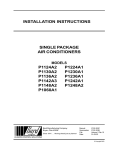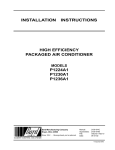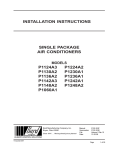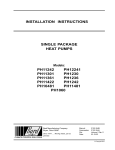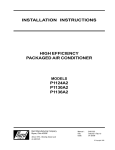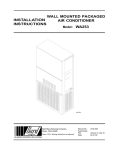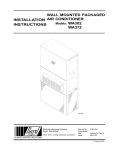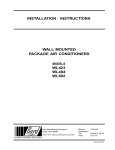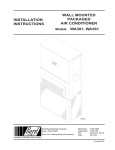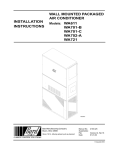Download Bard P1148A1 Specifications
Transcript
INSTALLATION INSTRUCTIONS SINGLE PACKAGE AIR CONDITIONERS MODELS P1142A3 P1148A1 P1060A1 Bard Manufacturing Company Bryan, Ohio 43506 Since 1914 . . . Moving ahead, just as planned Manual : Supersedes: File: Date: 2100-324B 2100-324A Volume II Tab 10 04-01-02 © Copyright 2002 Contents Getting Other Informations and Publications ........ 1 General Instructions Important ................................................................ Shipping Damage .................................................... General ................................................................ Field-Installed Heater Packages (Optional) ............. Figure 1 4 4 4 4 Installation Location ................................................................ 6 Typical Installations .................................................. 6 Condensate Drain Trap ............................................ 9 Air Filters ................................................................ 9 Wiring – Main Power .............................................. 10 Wiring – 24V Low Voltage Control Circuit .............. 10 Transformer Taps ................................................... 10 Thermostats ........................................................... 10 Start Up and Operation Three Phase Scroll Compressor Start Up Information .............................................................. 11 Sequence of Operation ........................................... 11 Start Up Notes ........................................................ 11 High Pressure Switch and Lockout Relay ............... 11 Service and Troubleshooting Service Hints ......................................................... Pressure Service Ports .......................................... Refrigerant Charge ................................................ Fan Blade Settings ................................................. Suction and Discharge Tube Brazing ..................... Pressure Table ....................................................... Figures 12 12 12 12 12 13 Prefabricated Rood Curb Specifications .......................................... 5 Figure 2 Field Fabricated Curbing ......................... 5 Figure3 Elevated Mounting Platforms .................. 7 Figure 4 Airflow and Service Access Clearances .............................................. 7 Figure 5 Roof Top Application ............................... 8 Figure 6 Slab Mounting at Ground Level ............... 8 Figure 7 Condensate Drain Trap ........................... 9 Figure 8 Low Voltage Wiring ............................... 10 Figure 9 Fan Blade Setting Dimensions .............. 12 Figure 10 Brazing Diagram ................................... 13 Tables Table 1 Table 2 Electrical Data ......................................... 2 Optional Field Installed Heater Packages ................................................ 2 Table 3 Optional Field Installed Heater Table ....... 3 Table 4 Maximum ESP of Operation ................... 4 Table 5 Rated CFM and Rated ESP .................... 6 Table 5A ESP in Inches H2O .................................. 6 Table 6 Air Filter Area and Size ........................... 9 Table 7 Thermostat Wire Size ........................... 10 Table 8 Wall Thermostat and Subbase Combinations ........................................ 10 Table 9 Refrigerant Charge ............................... 12 Table10 Pressure Table ...................................... 13 Getting Other Information and Publications These publications can help you install the air conditioner or heat pump. You can usually find these at your local library or purchase them directly from the publisher. Be sure to consult current edition of each standard. For more information, contact these publishers: ACCA Air Conditioning Contractors of America 1712 New Hampshire Ave. N.W. Washington, DC 20009 Telephone: (202) 483-9370 Fax: (202) 234-4721 ANSI American National Standards Institute 11 West Street, 13th Floor New York, NY 10036 Telephone: (212) 642-4900 Fax: (212) 302-1286 National Electrical Code ........................... ANSI/NFPA 70 Standard for the Installation .................. ANSI/NFPA 90A of Air Conditioning and Ventilating Systems Standard for Warm Air .......................... ANSI/NFPA 90B Heating and Air Conditioning Systems Load Calculation for ................................ ACCA Manual J Residential Winter and Summer Air Conditioning ASHRAE American Society of Heating, Refrigerating, and Air Conditioning Engineers, Inc. 1791 Tullie Circle, N.E. Atlanta, GA 30329-2305 Telephone: (404) 636-8400 Fax: (404) 321-5478 Duct Design for Residential .................... ACCA Manual D Winter and Summer Air Conditioning and Equipment Selection NFPA National Fire Protection Association Batterymarch Park P.O. Box 9101 Quincy, MA 02269-9901 Telephone: (800) 344-3555 Fax: (617) 984-7057 Manual 2100-324 Page 1 TABLE 1 ELECTRICAL DATA Q R Maximum External Fuses or Ckt. Brk. Minimum Circuit Ampacity Field Power Wiring Ground Wire Size Ckt. A Ckt. A Ckt. A Ckt. A R Rated Volts & Phases Operating Voltage Range Maximum Unit Amps P1142A3 230/208-1 197 - 253 24.2 45 29 8 10 P1148A1 240/208-1 197 - 253 26.1 50 36 8 10 P1148A1-B 230/208-3 187-253 18.8 35 23 8 10 P1148A1-C 460-3 414-506 8.5 20 13 12 12 P1060A1 230/208-1 197 - 253 33.9 60 42 8 10 P1060A1-B 230/208-3 187 - 253 23.7 45 28 8 10 P1060A1-C 460-3 414 - 506 11.2 20 14 12 12 Model Q R Maximum time delay fuse or HACR type circuit breaker. 75 degree C cooper wire size, basic unit only. TABLE 2 OPTIONAL FIELD INSTALLED HEATER PACKAGES ONLY TO BE USED WITH THE AIR CONDITIONING MODELS INDICATED Heater Package Volts and Model No. Phase P1142A3 P1148A1 P1148A1-B P1148A1-C P1160A1 P1160A1-B P1160A1-C S S S S S S S S A A A A A A A A S S S S A A A A A A A A EH5PB-A05 EH5PB-A10 EH5PB-A15 EH5PB-A20 240/1 EH5PB-B09 EH5PB-B15 EH5PB-B18 240/3 A A A S S S A A A A A A S S S A A A EH5PB-CO9 EH5PB-C15 EH5PB-B18 480/3 A A A A A A S S S A A A A A A S S S S – Standard application – Heater volts and phase same as basic unit A – Alternate application – Heater volts and phase different from basic unit Manual 2100-324 Page 2 TABLE 3 OPTIONAL FIELD-INSTALLED ELECTRIC HEATER TABLE Htr. KW & Capacity @ 240V (or 480V if applicable) Circuit B Htr. KW & Capacity @ 208 Volts @ 240V R Q S or 480V as Heater No. Minimum Maximum Field Ground applicable Internal Field Circuit Overcurrent Power Wire Htr. Amps Fuses Ckts. Ampacity Protection Wiring Size Heater Pkg. Model Unit Volts No. Phase KW BT UH EH5PB-A05 EH5PB-A10 EH5PB-A15 EH5PB-A20 240/208-1 240/208-1 240/208-1 240/208-1 5 10 15 20 17,100 3.75 34,100 7.50 51,200 11.25 68,200 15.00 12,800 26,000 38,400 51,200 20.8 41.7 62.5 83.2 EH5PB-B09 240/208-3 EH5PB-B15 240/208-3 EH5PB-B18 240/208-3 9 15 18 30,700 6.75 51,200 11.25 61,400 13.50 23,000 38,400 46,100 EH5PB-C09 460/3 EH5PB-C15 460/3 EH5PB-C18 460/3 9 15 18 30,700 6.75 23,000 51,200 11.25 38,400 61,400 13.50 46,100 Q R S KW BT UH 1 1 1 1 26 53 79 104 30 60 80 110 10 6 4 2 10 10 8 6 21.7 36.2 43.4 1 1 1 28 46 55 30 50 60 10 8 6 10 10 10 10.8 18.0 21.7 1 1 1 15 23 28 15 25 30 14 10 10 14 10 10 30/60 60/60 Time delay fuses or “HACR” type circuit breakers must be used for 60 and smaller sizes. Standard fuses or circuit breakers are suitable for sizes 70 and larger. Based on wire suitable for 75° C. Other wiring materials must be rated for marked “Minimum Circuit Ampacity” or greater. Based upon Table 250-95 of N.E.C. 1993. See electrical data for basic heat pump for Circuit A wiring specification requirements. IMPORTANT: While this electrical data is presented as a guide, it is important to electrically connect properly size fuses and conductor wires in accordance with the National Electrical Code and all existing local codes. Manual 2100-324 Page 3 GENERAL INSTRUCTIONS IMPORTANT The equipment covered in this manual is to be installed by trained, experienced service and installation technicians. All duct work, supply and return ducts, must be properly sized for the design air flow requirement of the equipment. ACCA is an excellent guide to proper sizing. All duct work or portions thereof not in the conditioned space should be properly insulated in order to both conserve energy and prevent condensation or moisture damage. SHIPPING DAMAGE Upon receipt of equipment, the carton should be checked for external signs of shipping damage. If damage is found, the receiving party must contact the last carrier immediately, preferably in writing, requesting inspection by the carrier’s agent. GENERAL The refrigerant system is completely assembled and charged. All internal wiring is complete. The unit is designed for use with or without duct work. Flanges are provided for attaching the supply and return ducts. These instructions explain the recommended method to install the air cooled self-contained unit and the electrical wiring connections to the unit. These instructions and any instructions packaged with any separate equipment required to make up the entire heat pump system should be carefully read before beginning the installation. Note particularly “Starting Procedure” and any tags and/or labels attached to the equipment. While these instructions are intended as a general recommended guide, they do not supersede any national and/or local codes in any way. Authorities having jurisdiction should be consulted before the installation is made. Manual 2100-324 Page 4 FIELD INSTALLED HEATER PACKAGES (OPTIONAL) These packaged heat pumps are manufactured without supplementary electric heaters. Supplementary heaters EH5PB series (to fit P1142A3, P1148A1, and P1160A1) are available for simple, fast, field installation. A separate field power circuit is required for the supplementary heaters. IMPORTANT: Refer to Table 4 and 5 when designing duct work for maximum available static pressure with heater installed. Refer to the electrical data shown on pages 2 and 3 for proper application information on all available heater combinations and what units they can be used with. It also shows the applicable circuit ampacities, fuse size, and wire size for each heater combination. Refer to the installation instructions packed with the heater for details on how to insert it into the basic unit. TABLE 4 MAXIMUM ESP OF OPERATION P1142A3 P1148A1 P1060A1 A00 A05 A10 A15 A20 .50 .50 .50 .40 .40 .50 .50 .50 .50 .50 .50 .50 .50 .50 .50 B00 B09 B15 B18 --------- .50 .50 .50 .50 .50 .50 .50 .50 C00 C09 C15 C18 --------- .50 .50 .50 .50 .50 .50 .50 .50 FIGURE 1 PREFABRICATED ROOF CURB SPECIFICATIONS HEAVY GAUGE GALVANIZED WITH WOOD NAILING STRIP, WELDED/LEAKPROOF ONE PIECE CONSTRUCTION – READY TO INSTALL MIS-1177 CURB AND ROOF DETAILS Roof Curb A 9042-004 82-3/8 B C* D E F J* H* Roof Hood Model 44-1/8 41-1/8 38-3/8 35-3/8 44 14-3/4 19-1/8 RHE60 *Duct Sizing Information Return Air Dimension “C” is length Return Air Dimension “H” is width Air Conditioning Units P1142A3, P1148A1, P1060A1 Supply Air Dimension “C” is length Supply Sir Dimension “J” is width FIGURE 2 FIELD FABRICATED CURBING Roof Hood Model Unit Model E RHE60 P1142A3 P1148A1 P1060A1 44-7/8 MIS-1178 Manual 2100-324 Page 5 INSTALLATION LOCATION GENERAL The unit must be located outside, or in a well ventilated area. It must not be in the space being heated or cooled. A sound absorbing material should be considered if the unit is to be installed in such a position or location that might cause transmission of sound or vibration to the living area or adjacent buildings. SLAB MOUNTING In areas where winter temperatures DO NOT go below 32° F for periods over twelve hours, the unit may be slab mounted at grade level. When installing unit at grade level, install on a concrete slab at least four inches above finished grade level. Slab should have a slope tolerance away from the building structure of at lease 1/4 inch per foot, while being level from side to side. Place slab in a location where runoff water from higher ground will not collect around unit. See Figure 3. A minimum of 18 inches should be provided between the coil inlet and any building surfaces. Provide at least four feet between coil outlet and any building wall, fences or other vertical structures. Provide a minimum of three feet clearance on the service access side of the unit. See Figure 4 ROOF MOUNTING When a unit is installed in areas where low ambient temperatures or strong winter winds exist, it should be placed for prevailing winter winds are not in direct line with the outdoor coil. If this is not possible, a wind barrier should be constructed. Place barrier 24 inches from the coil inlet side of the unit and in the direction of prevailing winds. Size barrier at least the same height and width as the unit. This may be necessary on ground level installations, also. See Figure 5. WINTER INSTALLATION BELOW 32°F In areas where winter conditions go below 32°F for extended periods, the unit must be elevated above the mounting surface to prevent snowfall or ice accumulation from interfering with the operation of the unit. A minimum of twelve inch elevation is recommended, while greater elevation may be required for areas of high snow accumulation. Poured concrete, steel framework, brick, cement block, etc., can be utilized to construct a suitable raised mounting platform. See Figure 6. DUCT WORK Refer to Tables 4, 5 and 5A when designing duct work for maximum static pressure available with the specific model and heater package being installed. Manual 2100-324 Page 6 TABLE 5 RATED CFM AND EXTERNAL STATIC PRESSURE (ESP) WET COIL (COOLING) Model Rated CFM Rated ESP Recommended Air Flow Range P1142A3 1400 .20 1260 - 1540 CFM P1148A1 1550 .40 1400 - 1700 CFM P1060A1 1700 .20 1530 - 1870 CFM TABLE 5A ESP Inches H2O 0 .1 .2 .3 .4 .5 P1142A3 PH11421 Dry / Wet 1650 / 1550 / 1435 / 1340 / 1230 / 1120 / 1625 1525 1400 1310 1210 1100 P1148A1 PH1048 Dry / Wet 1950 / 1860 / 1780 / 1680 / 1580 / 1500 / 1920 1830 1750 1660 1550 1480 P1060A1 PH1060 Dry / Wet 1850 / 1800 / 1725 / 1660 / 1580 / 1500 / 1850 1780 1700 1625 1540 1475 TYPICAL INSTALLATIONS 1. ROOF MOUNTED – The unit is mounted on a sturdy base on the roof of the building. Return air to the unit is brought through a single return grille (grilles with built-in filters are best since they enable easy access for filter changing). Return air ducts are attached to the lower section of the front panel. Supply air is brought from the unit to attic duct work or to a furred down hall. Supply air duct is attached to the top of the front panel. CAUTION: All outdoor duct work must be thoroughly insulated and weatherproofed. All attic duct work must be thoroughly insulated. Two inch thick insulation with suitable vapor barrier is recommended for both outdoor and attic runs. In roof top installation, as in all installations, the air conditioner must be level from side to side. However, the unit should have a pitch along the length to assure complete external drainage of precipitation and of defrost condensate. 2. CRAWL SPACE – Duct work installed in crawl space must be well insulated and provided with a vapor barrier. In addition, the crawl space must be thoroughly ventilated and provided with a good vapor barrier as a ground cover. It is most desirable to install the unit will be outdoors rather than inside the crawl space, so that it will be readily accessible for service. FIGURE 3 ELEVATED MOUNTING PLATFORMS MIS-1183 FIGURE 4 AIRFLOW AND SERVICE ACCESS CLEARANCES MIS-1185 Manual 2100-324 Page 7 FIGURE 5 ROOF TOP APPLICATION (MAY ALSO BE REQUIRED FOR GROUND LEVEL INSTALLATIONS.) MIS-1176 FIGURE 6 SLAB MOUNTING AT GROUND LEVEL (ABOVE 32° F OUTSIDE TEMPERATURE) MIS-1184 Manual 2100-324 Page 8 3. SLAB MOUNTED AT GROUND LEVEL – This type installation is ideal for homes with a slab floor construction where a roof mounted unit is not desired. The supply and return duct work can be run through a furred closet space. With a trap installed on a unit located in an unconditioned area, water in the trap may freeze. It is recommended that the trap material be of a type that will allow for expansion of water when it freezes. 4. THROUGH THE WALL – This type installation requires a suitable framework to be fabricated capable of withstanding the unit weight. Normally the unit will be insulated so as to minimize supply and return duct work. 5. OTHER INSTALLATIONS – Many other installations are possible with the packaged air conditioner. No matter what the installation, always consider the following facts: AIR FILTERS A. Insure that the discharge air is not obstructed inany way so as to cause operation difficulties. B. The indoor coil drain pan is equipped with a coupling that must be piped through a condensate drain trap to a suitable drain. C. Always mount the unit is such a position that it may be easily reached for servicing and maintenance. D. Insure that the unit is clear so that proper air flow over the outdoor coil will be maintained. Air filters for the return air side of the system are not provided as part of these models, and must be field supplied and installed as part of the final installation. Prior thought should be given to return air location and placement of the air filter(s). The air filter(s) must be of adequate size and readily accessible to the operator of the equipment. Filters must be adequate in size and properly maintained for proper operation. If this is not done, excessive energy use, poor performance, and multiple service problems will result. It is impossible to oversize air filters. Generous sizing will result in cleaner air and coils as well as lower operating costs and extend the time between required changes. Table 6 shows minimum filter areas and recommended filter sizes. Actual filter sizes can vary with the installation due to single or multiple returns utilizing a filter/grille arrangement or being placed immediately ahead of the indoor coil face in the return air duct. TABLE 6 RECOMMENDED FILTERS If this unit is operated in cooling below a 65° outdoor ambient temperature, the installation of low ambient controls (CMA-6) to unit is required. Model CONDENSATE DRAIN TRAP It is very important to provide a trap in the condensate drain line to allow a positive liquid seal in the line and assure correct drainage from the coil condensate pan. Install condensate drain trap shown in Figure 7. Use drain connection size or larger. Do not operate unit without trap. Unit must be level or slightly inclined toward drain. P1142A3 P1148A1 P1060A1 Minimum Filter Areas Recommended Size 608 square inches (4.62 square feet) (2) 16 x 20 x 1 NOTE: If roof hood accessory is to be used, information on air filters may be found under that heading in this manual. Air filters are supplied as part of that package. FIGURE 7 CONDENSATE DRAIN TRAP MIS-136 Manual 2100-324 Page 9 WIRING – MAIN POWER Refer to the unit rating plate for wire sizing information and maximum fuse size. Each outdoor unit is marked with a “Minimum Circuit Ampacity”. This means that the field wiring used must be sized to carry that amount of current. If field installed heaters are added to the basic unit, a second separate power supply circuit will be required. The heater rating plate located adjacent to the basic unit rating plate will show the appropriate circuit ampacity fuse size, etc. (Also see “Electrical Data” on pages 2 and 3.) All models are suitable for connection with copper wire only. These instructions must be adhered to. Refer to the National Electrical Code for complete current carrying capacity data on the various insulation grades of wiring material. The electrical specifications on page 2 and 3 lists fuse and wire sizes (75°F copper) for all models including the most commonly used heater sizes. The unit rating plate lists a “Maximum Time Delay Fuse” or “HACR” type circuit breaker that is to be used with the equipment. The correct size must be used for proper circuit protection and also to assure that there will be no nuisance tripping due to the momentary high starting current of the compressor. TABLE 7 THERMOSTAT WIRE SIZE Transformer VA 55 FLA Wire Gauge 2.3 20 18 16 14 12 Maximum Distance In Feet 45 60 100 160 250 TRANSFORMER TAPS 230/208V, 1 phase and 3 phase equipment employ dual primary voltage transformers. All equipment leaves the factory wired on 240V tap. For 208V operation, reconnect from 240V to 208V tap. The acceptable operating voltage range for the 240 and 208V taps are: TAP RANGE 240 253 – 216 208 220 – 187 NOTE: The voltage should be measured at the field power connection point in the unit and while the unit is operating at full load (maximum amperage operating condition). WIRING – 24V LOW VOLTAGE CONTROL CIRCUIT Five (5) wires should be run from thermostat subbase to the 24V terminal board in the unit. A five conductor, 18 gauge copper, color-coded thermostat cable is recommended. The connection points are shown in Figure 8. THERMOSTATS See specific wiring information for the different models, heater KWs, and voltages on pages 14 through 17. TABLE 8 WALL THERMOSTAT AND SUBBASE COMBINATIONS Thermostat S u b b ase Predominate Features 8403-002 T87F3111 8404-003 Q539A1220 1 stage heat, 1 stage cool, Mercury System: Heat-off-cool Fan: on-auto 8403-041 T8034C1499 —— 1 stage heat, 1 stage cool, Mercury System: Heat-off-cool Fan: on-auto 8403-049 1F93-380 —— 2 stage heat, 2 stage cool Electronic Programmable 8403-043 CM200 —— 1 stage heat, 1 stage cool, Mercury System: Heat-off-cool Fan: on-auto Snap Action 8403-048 T8400C1313 —— 1 stage heat, 1 stage cool, Mercury System: Heat-off-cool Fan: on-auto Electronic Non-Programmable 8403-019 T874C1760 8404-012 Q674A1001 2 stage heat, 1 stage cool, Mercury System: heat-auto-cool Fan: on-auto IMPORTANT NOTE: Only the thermostat and subbase combinations as shown above will work with this equipment. The thermostat and subbase MUST be matched, and correct operation can be assured only by proper selection and application of these parts. Manual 2100-324 Page 10 FIGURE 8 LOW VOLTAGE WIRING MIS-1180 Manual 2100-324 Page 11 START UP AND OPERATION THREE PHASE SCROLL COMPRESSOR START UP INFORMATION Scroll compressors, like several other types of compressors, will only compress in one rotational direction. Direction of rotation is not an issue with single phase compressors since they will always start and run in the proper direction. However, three phase compressors will rotate in either direction depending upon phasing of the power. Since there is a 50-50 chance of connecting power in such a way as to cause rotation in the reverse direction, verification of proper rotation must be made. Verification of proper rotation direction is made by observing that suction pressure drops and discharge pressure rises when the compressor is energized. Reverse rotation also results in an elevated sound level over that with correct rotation, as well as, substantially reduced current draw compared to tabulated values. Verification of proper rotation must be made at the time the equipment is put into service. If improper rotation is corrected at this time there will be no negative impact on the durability of the compressor. However, reverse operation for over one hour may have a negative impact on the bearing due to oil pump out. NOTE: If compressor is allowed to run in reverse rotation for several minutes the compressor’s internal protector will trip. All three phase ZR*3 compressors are wired identically internally. As a result, once the correct phasing is determined for a specific system or installation, connecting properly phased power leads to the same Fusite terminals should maintain proper rotation direction. START UP NOTES For improved start up performance, wash the indoor coil with dishwasher detergent COMPRESSOR CONTROL MODULE The compressor control is an anti-short cycle/lockout timer with high and low pressure switch monitoring and alarm output. ADJUSTABLE DELAY-ON-MAKE AND BREAK TIMER On a call for compressor operation the delay-on-make period begins which will be 10% of the delay-on-break setting. When the delay-on-make is complete and the high pressure switch (and low pressure switch if employed) is closed, the compressor contactor is energized. Upon shutdown the delay-on-break timer starts and prevents restart until the delay-on-break and delay-on-make periods have expired. HIGH PRESSURE SWITCH AND LOCKOUT SEQUENCE (Standard Feature) If the high pressure switch opens, the compressor contactor will de-energize immediately. The lockout timer will go into a soft lockout and stay in soft lockout until the high pressure switch closes and the delay-on-make time has expired. If the high pressure switch opens again in this same operating cycle the unit will go into manual lockout condition and the alarm circuit will energize. Recycling the wall thermostat resets the manual lockout. The direction of rotation of the motor may be changed by reversing any two line connections to the unit. LOW PRESSURE SWITCH, BYPASS, AND LOCKOUT SEQUENCE SEQUENCE OF OPERATION NOTE: The low pressure switch is an optional control and the bypass and lockout sequence are part of the standard compressor control module. COOLING – Circuit R-Y makes at thermostat pulling in compressor contactor starting the compressor and outdoor motor. The G (indoor motor) circuit is automatically completed on any call for cooling operation, or can be energized by manual fan switch on subbase for constant air circulation. HEATING – A circuit R-W1 is completed on each heating cycle energizing electric heat if so equipped. Manual 2100-324 Page 12 If the low pressure switch opens for more that 120 seconds, the compressor contactor will de-energize and go into a soft lockout. Regardless the state of the low pressure switch, the contactor will reenergize after the delay-on-make time delay has expired. If the low pressure switch remains open or opens again for longer than 120 seconds the unit will go into manual lockout condition and the alarm circuit will energize. Recycling the wall thermostat resets the manual lockout. ALARM OUTPUT ADJUSTMENTS Alarm terminal is output connection for applications where alarm signal is desired. This terminal is powered whenever compressor is locked out due to HPC or LPC sequences as described. ADJUSTABLE DELAY-ON-MAKE AND DELAY-ON-BREAK TIMER NOTE: Both high and low pressure switch controls are inherently automatic reset devices. The high pressure switch and low pressure switch cut out and cut in settings are fixed by specific air conditioner or heat pump unit model. The lockout features, both soft and manual, are a function of the Compressor Control Module. The potentiometer is used to select Delay-on-Break time from 30 seconds to 5 minutes. Delay-on-Make (DOM) timing on power-up and after power interruptions is equal to 2 minutes plus 10% of Delay-on-Break (DOB) setting: 0.5 minute 1.0 minute 2.0 minute 3.0 minute 4.0 minute 5.0 minute (30 seconds) (60 seconds) (120 seconds) (160 seconds) (240 seconds) (300 seconds) DOB DOB DOB DOB DOB DOB = = = = = = 123 second DOM 126 second DOM 132 second DOM 138 second DOM 144 second DOM 150 second DOM Manual 2100-324 Page 13 SERVICE AND TROUBLESHOOTING FIGURE 9 FAN BLADE SETTING DIMENSIONS SERVICE HINTS 1. Caution homeowner to maintain clean air filters at all times. Also, not to needlessly close off supply and return air registers. This reduces air flow through the system which shortens equipment service life as well as increasing operating costs. 2. Check all power fuses or circuit breakers to be sure that they are the correct rating. 3. Periodic cleaning of the outdoor coil to permit full and unrestricted airflow circulation is essential. Model Dimension A P1142A3 P1148A1 P1060A1 1.75" 1.75" 1.75" PRESSURE SERVICE PORTS High and low pressure service ports are installed on all units so that the system operating pressures can be observed. Pressure tables can be found in Table 10 in this manual covering all models on cooling cycle. It is imperative to match the correct pressure table to the unit by model number. REFRIGERANT CHARGE The correct system R-22 charge is shown on the unit rating plate. Optimum unit performance will occur with a refrigerant charge resulting in a suction line temperature (6” from compressor) as shown in Table 9. TABLE 9 Model Rated Airflow 95 Degree F OD Temperature 82 Degree F OD Temperature P1142A3 P1148A1 P0160A1 1400 1550 1700 57 - 59 55 - 57 47 - 49 58 - 60 59 - 61 54 - 56 The above suction line temperatures are based upon 80°F dry bulb/67°F wet bulb (50% RH) temperature and rated airflow across the evaporator during cooling cycle. FAN BLADE SETTINGS SUCTION AND DISCHARGE TUBE BRAZING Compliant Scroll compressors have copper plated steel suction and discharge tubes. These tubes are far more rugged and less prone to leaks than copper tubes used on other compressors. Due to different thermal properties of steel and copper, brazing procedures may have to be changed from those commonly used. • To disconnect: heat joint Areas 2 and 3 slowly and uniformly until braze material softens and the tube can be pulled out of suction fitting. (See Figure 10.) • To connect: – Recommended brazing materials: silfos with minimum 5% silver or silver braze material with flux. – Reinsert tube into fitting. – Heat tube uniformly in Area 1 moving slowly to Area 2. When joint reaches brazing temperature, apply brazing material. (See Figure 10.) – Heat joint uniformly around the circumference to flow braze material completely around the joint. – Slowly move torch into Area 3 to draw braze material into joint. (See Figure 10.) – Do not overheat joint. Shown in Figure 9 are the correct fan blade setting dimensions for proper air delivery across the outdoor coil. Any service work requiring removal or adjustment in the fan and/or motor area will require that the dimensions below be checked and blade adjusted in or out on the motor shaft accordingly. Manual 2100-324 Page 14 FIGURE 10 BRAZING DIAGRAM MIS-1179 TABLE 10 PRESSURE TABLE COOLING Air Temperature Entering Outdoor Coil Degrees F Model P1142A3 P1148A1 P1060A1 Return Air Pressure Temperature 75 80 85 90 95 100 105 110 115 75 deg. DB 62 deg. WB Low Side High Side 70 208 72 223 75 239 77 254 78 271 79 288 80 305 81 324 82 342 80 deg. DB 67 deg. WB Low Side High Side 75 213 77 229 80 245 82 261 84 278 85 295 96 313 87 332 88 351 85 deg. DB 72 deg. WB Low Side High Side 81 220 83 237 86 254 88 270 90 288 91 305 92 324 94 344 95 363 75 deg. DB 62 deg. WB Low Side High Side 73 203 74 217 75 231 76 246 78 264 79 278 80 294 81 312 82 330 80 deg. DB 67 deg. WB Low Side High Side 78 208 79 222 81 237 82 252 83 268 84 285 86 302 87 320 88 338 85 deg. DB 72 deg. WB Low Side High Side 83 215 85 230 87 245 88 261 87 273 91 295 92 313 93 331 94 350 75 deg. DB 62 deg. WB Low Side High Side 65 214 66 230 68 247 69 264 70 284 72 299 74 318 75 336 76 355 80 deg. DB 67 deg. WB Low Side High Side 69 219 71 236 72 253 74 271 76 289 77 307 79 326 80 345 82 364 85 deg. DB 72 deg. WB Low Side High Side 74 227 76 244 78 262 79 280 81 296 83 318 85 337 86 357 88 377 Manual 2100-324 Page 15 Manual 2100-324 Page 16 Manual 2100-324 Page 17 Manual 2100-324 Page 18 Manual 2100-324 Page 19 Manual 2100-324 Page 20 Manual 2100-324 Page 21























